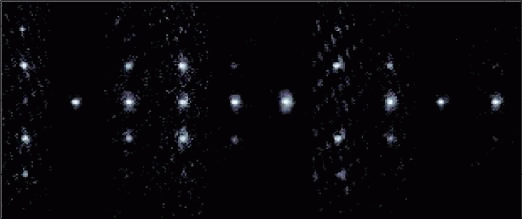|
Physicists use Bose-Einstein
condensates to enhance factoring algorithm

An absorption image of the expanding
Bose-Einstein condensate, demonstrating the diffraction pattern
which constitutes the factoring signal. Image credit: Mark
Sadgrove, et al.
PhysOrg.com) -- Theoretically, quantum computing
has the potential to work more efficiently and accurately than
classical computing for certain processes, such as factoring.
But quantum methods are experimentally challenging, since they
often require tiny, fragile systems that are difficult to
handle.
Recently, some approaches have suggested “rediscovering” old
techniques such as analog computing, which usually lie outside
the usual qubit architecture, in the hope of finding new
pathways to experimentally realize quantum computation. For
instance, using analog techniques and the quantum properties of
atomic clusters called Bose-Einstein condensates, a team of
researchers from Japan has recently improved upon a classical
factoring algorithm.
“Any
algorithm where the output is continuous rather than divided
into bits (as on a digital computer) is analog,” Mark Sadgrove
of the Japan Science and Technology Agency (JSTA) told PhysOrg.com.
“In our case, we measure quantities which are continuous in
principle. By this I mean that the energy or the probability to
find an atom with a given momentum are continuous variables, in
theory. In practice, we use a finite number of atoms, so in some
sense the final outputs are discrete, but theoretically the
result of the computation is analog in nature.”
Sadgrove and his colleagues Sanjay Kumar of the University of
Electro Communications (UEC) in Chofushi, Chofugaoka, and
Ken’ichi Nakagawa, who has affiliations with both JSTA and UEC,
have demonstrated that, compared with the classical
implementation, their method can distinguish more accurately
between factors and non-factors of large numbers. Specifically,
their quantum system could increase the accuracy of a classical
algorithm called the Gauss sum algorithm, a technique pioneered
by Wolfgang Shleich of Ulm University in Germany.
Their quantum system consists of thousands of rubidium-87 atoms
that are cooled to near absolute zero to form a Bose-Einstein
condensate (BEC). At such a low temperature, the atoms’
wavelengths increase and overlap, so that the cluster becomes a
single quantum state and obeys quantum laws, yet has a
relatively large size.
The physicists zapped the BEC with a brief light pulse composed
of two counter-propagating beams. They programmed one beam to
have phase jumps (to displace the beam’s wavelength), while the
second beam had no phase jumps. Programming the first beam
served as the input method, representing an integer to be
factored.
The dynamics of the atoms subject to the pulse could then be
used to perform factoring calculations. After applying the
pulse, the researchers allowed the BEC to expand freely for 14
ms. They then took an absorption image of the BEC, which showed
that the pulse had separated the atoms in the BEC into different
momentum orders. The atoms formed a diffraction pattern, based
on the relative number of atoms in each momentum order, which
the physicists could interpret as the “factoring signal.”
Specifically, high-momentum atoms represented factors, and
low-momentum atoms represented non-factors.
“You can think of the laser beam as containing the software
(encoded by phase jumps) and the atoms as providing the hardware
(their natural dynamics in response to the light field is what
actually calculates the Gauss sum),” Sadgrove explained.
In contrast to the usual Gauss sum, which is fundamentally
limited in its accuracy, the quantum method significantly
outperformed the classical method, in some cases doubling the
atomic visibility and offering near-perfect factoring.
“In our case, our current method is still slow – it doesn't make
factoring easy,” Sadgrove said. “What we showed is that quantum
mechanics offers an unexpected improvement to the Gauss sum
method, overcoming a fundamental accuracy limit. If the atoms
behaved classically, there would be no enhancement.”
The researchers noted that the higher accuracy comes at a cost
of requiring more atoms, so the quantum method’s efficiency is
about the same as that of the classical method. Nonetheless, as
Sadgrove explained, the method offers a novel experiment in a
field in which experiments are difficult to realize.
“You might know that everyone doing research in quantum
information is excited about [Peter] Shor's algorithm for
quantum factoring,” Sadgrove said. “Shor found a remarkable way
to factor numbers using the quantum properties of interference
and entanglement, which offers amazing savings in the time it
takes for factoring a number. But Shor's algorithm is hard to
implement. It's only been done successfully for up to the number
15 at the moment, and some people don't even consider that to be
a real test due to some details about the way the algorithm
works. So that's the current state of play regarding quantum
factoring.”
He added that researchers continue to investigate Shor’s
algorithm because of its potential impact on security: “In terms
of applications, there's just one, but it's very important. If
you could do real quantum factoring, then the RSA encryption
used to do secure transactions in public situations would be no
good anymore. That's because it relies on the fact that
factoring large numbers is a hard problem. But quantum factoring
makes it easy.”
In the future, the physicists hope to use entangled systems as a
factoring method, which they say the present scheme is ideally
suited for. They also plan to investigate the use of multiple,
correlated atomic ensembles to perform factoring of different
integers simultaneously.
“We would also like to extend the method beyond factoring,”
Sadgrove said. “We can actually compute general ‘exponential
sums’ with this method. A Gauss sum is a simple example of an
exponential sum, as is a Fourier transform, which can be used to
extract information about a signal. These so called ‘exponential
sums’ are intricately tied to the most interesting parts of
number theory, such as the distribution of prime numbers, which
is still unknown. We think there may be other powerful
applications of exponential sums apart from factoring.”
http://www.physorg.com/news145535050.html
1 2 3 4 5 6 7 8 9 10 Newest
articles
|

